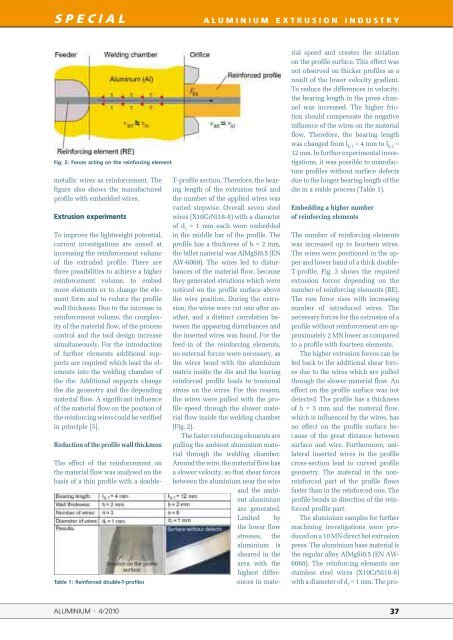special - Alu-web.de
special - Alu-web.de
special - Alu-web.de
You also want an ePaper? Increase the reach of your titles
YUMPU automatically turns print PDFs into web optimized ePapers that Google loves.
SPECIAL<br />
Fig. 2: Forces acting on the reinforcing element<br />
metallic wires as reinforcement. The<br />
figure also shows the manufactured<br />
profile with embed<strong>de</strong>d wires.<br />
Extrusion experiments<br />
To improve the lightweight potential,<br />
current investigations are aimed at<br />
increasing the reinforcement volume<br />
of the extru<strong>de</strong>d profile. There are<br />
three possibilities to achieve a higher<br />
reinforcement volume, to embed<br />
more elements or to change the element<br />
form and to reduce the profile<br />
wall thickness. Due to the increase in<br />
reinforcement volume, the complexity<br />
of the material flow, of the process<br />
control and the tool <strong>de</strong>sign increase<br />
simultaneously. For the introduction<br />
of further elements additional supports<br />
are required which lead the elements<br />
into the welding chamber of<br />
the die. Additional supports change<br />
the die geometry and the <strong>de</strong>pending<br />
material flow. A significant influence<br />
of the material flow on the position of<br />
the reinforcing wires could be verified<br />
in principle [5].<br />
Reduction of the profile wall thickness<br />
The effect of the reinforcement on<br />
the material flow was analysed on the<br />
basis of a thin profile with a double-<br />
Table 1: Reinforced double-T-profiles<br />
ALUMINIUM · 4/2010<br />
ALUMINIUM EXTRUSION INDUSTRY<br />
T-profile section. Therefore, the bearing<br />
length of the extrusion tool and<br />
the number of the applied wires was<br />
varied stepwise. Overall seven steel<br />
wires (X10CrNi18-8) with a diameter<br />
of d r = 1 mm each were embed<strong>de</strong>d<br />
in the middle bar of the profile. The<br />
profile has a thickness of h = 2 mm,<br />
the billet material was AlMgSi0.5 (EN<br />
AW-6060). The wires led to disturbances<br />
of the material flow, because<br />
they generated striations which were<br />
noticed on the profile surface above<br />
the wire position. During the extrusion,<br />
the wires were cut one after another,<br />
and a distinct correlation between<br />
the appearing disturbances and<br />
the inserted wires was found. For the<br />
feed-in of the reinforcing elements,<br />
no external forces were necessary, as<br />
the wires bond with the aluminium<br />
matrix insi<strong>de</strong> the die and the leaving<br />
reinforced profile leads to tensional<br />
stress on the wires. For this reason,<br />
the wires were pulled with the profile<br />
speed through the slower material<br />
flow insi<strong>de</strong> the welding chamber<br />
(Fig. 2).<br />
The faster reinforcing elements are<br />
pulling the ambient aluminium material<br />
through the welding chamber.<br />
Around the wire, the material flow has<br />
a slower velocity, so that shear forces<br />
between the aluminium near the wire<br />
and the ambient<br />
aluminium<br />
are generated.<br />
Limited by<br />
the lower flow<br />
stresses, the<br />
aluminium is<br />
sheared in the<br />
area with the<br />
highest differences<br />
in mate-<br />
rial speed and creates the striation<br />
on the profile surface. This effect was<br />
not observed on thicker profiles as a<br />
result of the lower velocity gradient.<br />
To reduce the differences in velocity,<br />
the bearing length in the press channel<br />
was increased. The higher friction<br />
should compensate the negative<br />
influence of the wires on the material<br />
flow. Therefore, the bearing length<br />
was changed from l b,1 = 4 mm to l b,2 =<br />
12 mm. In further experimental investigations,<br />
it was possible to manufacture<br />
profiles without surface <strong>de</strong>fects<br />
due to the longer bearing length of the<br />
die in a stable process (Table 1).<br />
Embedding a higher number<br />
of reinforcing elements<br />
The number of reinforcing elements<br />
was increased up to fourteen wires.<br />
The wires were positioned in the upper<br />
and lower band of a thick double-<br />
T-profile. Fig. 3 shows the required<br />
extrusion forces <strong>de</strong>pending on the<br />
number of reinforcing elements (RE).<br />
The ram force rises with increasing<br />
number of introduced wires. The<br />
necessary forces for the extrusion of a<br />
profile without reinforcement are approximately<br />
2 MN lower as compared<br />
to a profile with fourteen elements.<br />
The higher extrusion forces can be<br />
led back to the additional shear forces<br />
due to the wires which are pulled<br />
through the slower material flow. An<br />
effect on the profile surface was not<br />
<strong>de</strong>tected. The profile has a thickness<br />
of h = 5 mm and the material flow,<br />
which is influenced by the wires, has<br />
no effect on the profile surface because<br />
of the great distance between<br />
surface and wire. Furthermore, unilateral<br />
inserted wires in the profile<br />
cross-section lead to curved profile<br />
geometry. The material in the nonreinforced<br />
part of the profile flows<br />
faster than in the reinforced one. The<br />
profile bends in direction of the reinforced<br />
profile part.<br />
The aluminium samples for further<br />
machining investigations were produced<br />
on a 10 MN direct hot extrusion<br />
press. The aluminium base material is<br />
the regular alloy AlMgSi0.5 (EN AW-<br />
6060). The reinforcing elements are<br />
stainless steel wires (X10CrNi18-8)<br />
with a diameter of d r = 1 mm. The pro-<br />
37
















